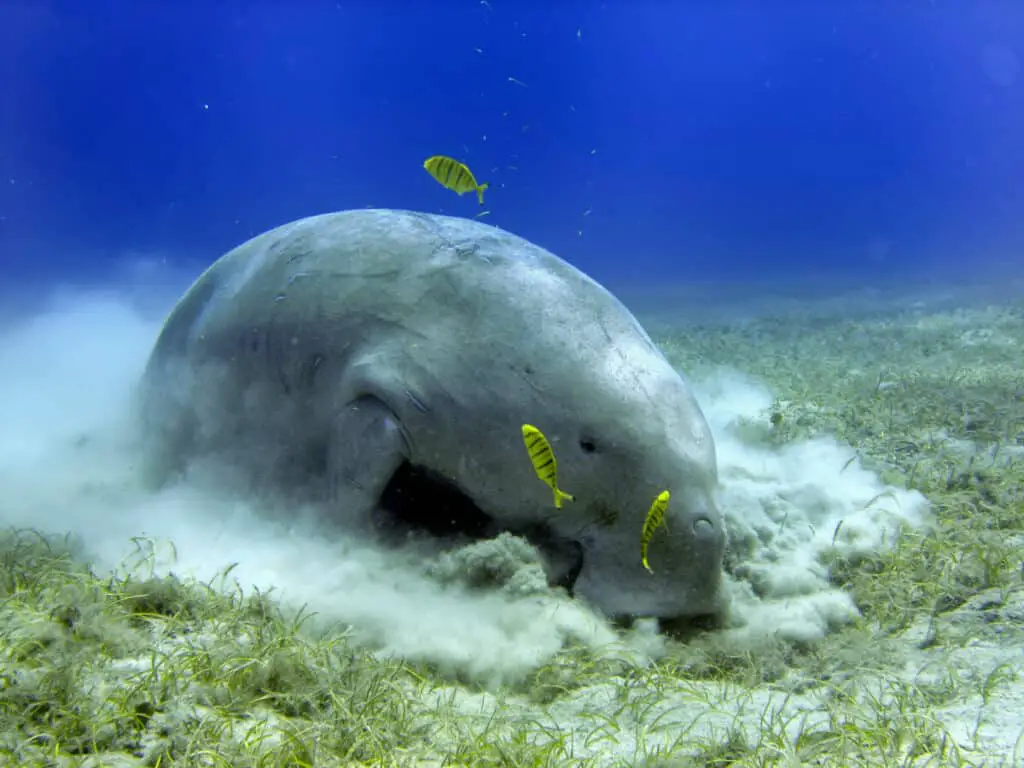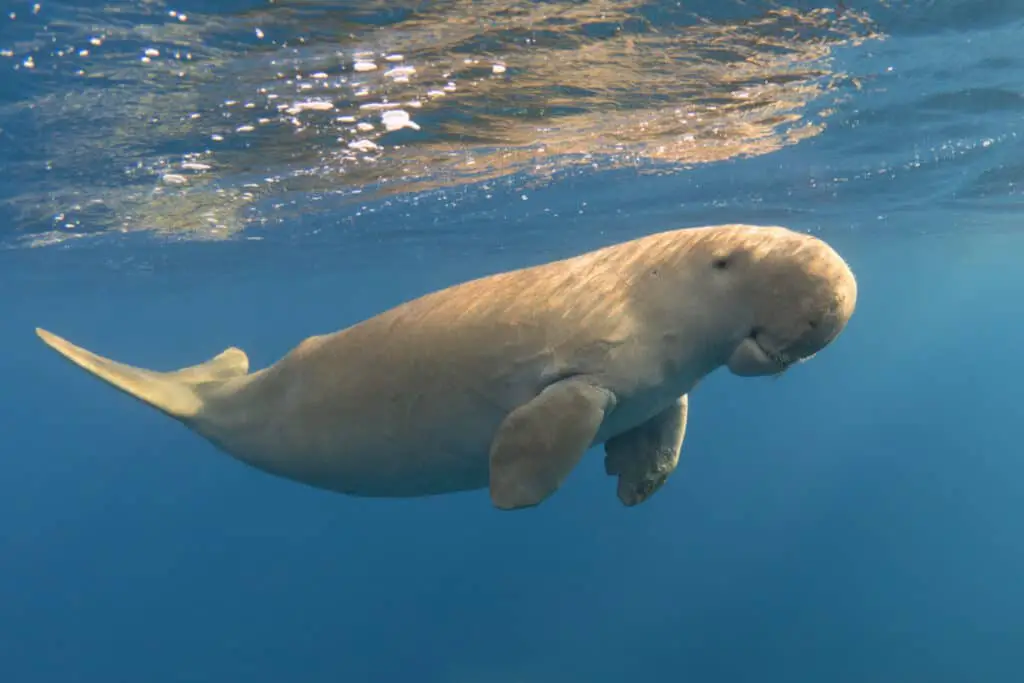Dugongs are marine mammals belonging to the order Sirenia, which also includes manatees. They are known for their unique physical appearance and gentle behavior, making them a popular subject of study among marine biologists and conservationists.
Dugongs have been present in coastal waters throughout the world for millions of years and play an important role in maintaining healthy seagrass ecosystems.
Despite their importance, dugong populations have declined significantly due to human activities such as overfishing, habitat destruction, and pollution.
This article will provide an overview of dugongs including their physical characteristics, distribution, diet, behavior, and conservation status. Additionally, it will explore the various threats facing these animals and efforts being made to protect them.
By increasing awareness about dugongs and promoting conservation measures, we can help ensure the survival of this iconic species for generations to come.

Physical Characteristics Of Dugongs
As one of the four extant species of sea cows, dugongs are large marine mammals that inhabit shallow coastal waters and can be found in areas ranging from East Africa to Australia.
These gentle creatures possess a unique set of physical characteristics that distinguish them from other aquatic animals.
The size and shape of dugongs, for instance, is an important feature that defines this species.
They have a streamlined body with paddle-like flippers, which allows them to glide effortlessly through the water at speeds up to 15 miles per hour.
Another notable characteristic of dugongs is their skin and coloration.
Their rough-textured grayish-brown skin provides a protective layer against parasites and predators while also helping them maintain buoyancy by trapping air bubbles close to their bodies.
Additionally, they have small eyes and nostrils located on the top of their heads, allowing them to surface quickly for air without exposing too much of their body above the waterline.
Dugongs’ striking features make them fascinating creatures worthy of study and admiration for both scientists and nature enthusiasts alike.
Dugongs’ Predators Exposed: Unveiling the Threats
Distribution And Habitat
Dugongs are primarily found in the shallow waters of the Indo-Pacific region, stretching from East Africa to Australia. They inhabit coastal areas such as bays, lagoons, and coral reefs that have seagrass meadows, their primary food source.
Dugongs prefer these habitats because they provide them with shelter and protection while also offering access to ample amounts of seagrasses. The geographical range of dugongs is limited to tropical and subtropical regions where water temperatures remain warm throughout the year.
These marine mammals can be found in several countries, including Madagascar, Mozambique, India, Thailand, Malaysia, Indonesia, Papua New Guinea, Northern Australia among others. Seagrass meadows serve as vital feeding grounds for dugongs; hence conservation efforts should focus on preserving these ecosystems by reducing human activities along coastlines and implementing sustainable fishing practices.
Diet And Feeding Habits
Dugongs are herbivorous marine mammals that feed primarily on seagrass, a type of underwater flowering plant. They have several adaptations that allow them to efficiently consume and digest their preferred food source.
One such adaptation is their elongated snout and upper lip, which they use to root out seagrass from the ocean floor. Dugongs also have molar-like teeth that continuously grow throughout their lifetime to help grind up tough seagrass fibers.
Studies have shown that dugongs can consume up to 40-50 kilograms of seagrass per day, depending on their size and age. Their herbivorous tendencies make them important grazers in coastal ecosystems, as they prevent overgrowth of seagrasses by consuming excess vegetation.
However, human activities such as coastal development and pollution have resulted in habitat loss and degradation for dugongs, leading to declines in their populations across many parts of their range.
Sirenians in Peril: Why We Must Preserve These Unique Creatures
Behavior And Social Interactions
While dugongs may seem like gentle giants, their behavior and social interactions can be quite complex. Despite their sluggish appearance, they are highly intelligent animals with intricate communication patterns.
Dugongs use a variety of vocalizations to communicate with each other, including chirps, whistles, and grunts. These sounds allow them to locate one another and establish dominance hierarchies.
In addition to communication patterns, mating rituals also play an important role in the behavior of dugongs. During breeding season, males will engage in elaborate courtship displays to attract females. This includes swimming laps around potential mates while emitting low-frequency calls that can be heard from a distance.
Once paired off, male and female dugongs stay together for several weeks before separating again until the next breeding season. Understanding these behaviors is crucial in conservation efforts aimed at protecting this vulnerable species from human activities such as hunting and habitat destruction.
Diving into the Sensory World of Dugongs: How Good Are Their Senses?

Conservation Status And Threats
The dugong is classified as vulnerable by the International Union for Conservation of Nature (IUCN) due to population decline caused by human impact. The species’ vulnerability stems from a range of threats, including:
- Habitat loss and degradation
- Entanglement in fishing gear
- Hunting for subsistence and commercial purposes
- Pollution – Pollution of their oceanic environment, including plastic debris and chemical contaminants, which can harm or kill turtles directly or indirectly through the food chain.
In recent years, populations have declined significantly across much of their range due to increasing human activities such as coastal development, overfishing and illegal hunting practices. In some countries alone, it is estimated that hundreds are killed annually. These factors not only directly affect the survival of individual dugongs but also lead to changes within their ecosystem which can negatively impact other marine life.
Urgent conservation measures are needed to protect this iconic species before it becomes critically endangered or even extinct.
Conservation Efforts And Future Outlook
Collaborative initiatives and community engagement have played a significant role in the conservation efforts for dugongs. Many organizations, government agencies, and local communities have come together to develop plans and strategies that aim to protect this iconic marine mammal from threats such as habitat loss, accidental entanglement in fishing gear, and hunting. These collaborative efforts involve conducting researches on dugong populations, implementing regulations on fishing activities, establishing protected areas, educating coastal communities about the importance of dugongs, among others.
Furthermore, these initiatives are expected to continue to shape the future outlook for dugong conservation positively. However, much work still needs to be done since dugongs’ population continues to decline globally due to various factors. Therefore, it is crucial that all stakeholders involved should remain committed and proactive towards protecting this species’ survival through continued collaboration and community engagement efforts. Through concerted conservation actions across different sectors, there is hope that dugongs will thrive once again in their natural habitats.
| Conservation Strategies | Description | Advantages | Limitations |
|---|---|---|---|
| Establishment of Protected Areas | Designated areas where no extractive activities occur; only certain types of non-extractive uses allowed (e.g., ecotourism) | Provides a safe haven for Dugongs by reducing human impacts within their critical habitats | Limited effectiveness without enforcement measures |
| Regulation of Fishing Activities | Implementation of restrictions or bans on fishing methods known to impact Dugongs directly (e.g., gillnets); promoting sustainable fisheries practices | Reduces direct mortality rates caused by fishing activities | Difficulty enforcing regulations effectively; lack of compliance from some fishers |
| Community-based Conservation Education Programs | Engaging with local communities who depend on coastal resources by providing education & training programs centered around Dugong biology/ecology; encouraging alternative livelihoods | Increases awareness & understanding of Dugong’s ecological value; fosters community stewardship | Difficult to measure long-term effectiveness; requires substantial investment in resources & time |
| Research and Monitoring Programs | Collecting data on Dugong populations, habitat use patterns, threats affecting their survival, etc. | Provides critical information for effective conservation planning | Expensive & often require specialized technical expertise; limited availability of funding opportunities |
Conclusion
The dugong, a marine mammal found in shallow waters of the Indo-Pacific region, is a fascinating creature with unique physical adaptations.
With their elongated bodies and paddle-like flippers, they are expert swimmers that feed on seagrass beds.
Dugongs have social interactions among themselves and other species such as dolphins and sea turtles.
Despite its important ecological role, dugongs face numerous threats including habitat loss due to coastal development and entanglement in fishing nets.
Conservation efforts range from implementing protected areas to reducing bycatch through fishing gear modifications.
These conservation measures aim to ensure the survival of this endangered species for future generations.
In conclusion, it is imperative that we take action to protect the vulnerable dugong population before it’s too late.
The fate of this gentle giant lies in our hands as humans who share this planet with them.
As George Bernard Shaw once said, ‘We are made wise not by the recollection of our past but by the responsibility for our future.’
Let us all step up and be responsible custodians of our environment so that these magnificent creatures can continue to thrive in their natural habitats for years to come.

